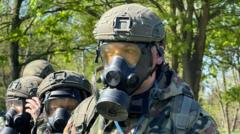Poland's military readiness has reached new heights, with Prime Minister Donald Tusk advocating for the development of the region's strongest army. Defense spending is set to increase to nearly 5% of GDP, marking an unprecedented commitment within NATO. Local participants, like Dariusz and Agata, express a sense of urgency, aware of historical conflicts that have shaped their perception of security. Worries have intensified following changes in U.S. military presence; as officials contemplate defense collaborations with France and the UK, Poland's military commitments evolve.
Historically, Poland has faced challenges from neighboring states, leading to significant governmental plans to enhance military capabilities. A notable increase in the armed forces is projected, with an intent to boost troop numbers to 500,000, thus positioning Poland to play a crucial role in NATO and resist any potential threats. Yet, despite the military surge, recent polls indicate a mixed sentiment among the general population regarding their willingness to fight. As the country braces for uncertainty, the historical weight of previous conflicts looms large, influencing contemporary preparedness and defense strategies.
While some express readiness to defend their homeland, others demonstrate a palpable sense of apprehension regarding the future. The rapid construction of bomb shelters across the nation symbolizes the fears many harbor, as they look towards an unpredictable geopolitical landscape. Even amidst the rising number of volunteers and military enthusiasts, cultural hesitations persist—a narrative that encapsulates the complex sentiments of a nation facing a dark historical reality intertwined with modern-day concerns.
Historically, Poland has faced challenges from neighboring states, leading to significant governmental plans to enhance military capabilities. A notable increase in the armed forces is projected, with an intent to boost troop numbers to 500,000, thus positioning Poland to play a crucial role in NATO and resist any potential threats. Yet, despite the military surge, recent polls indicate a mixed sentiment among the general population regarding their willingness to fight. As the country braces for uncertainty, the historical weight of previous conflicts looms large, influencing contemporary preparedness and defense strategies.
While some express readiness to defend their homeland, others demonstrate a palpable sense of apprehension regarding the future. The rapid construction of bomb shelters across the nation symbolizes the fears many harbor, as they look towards an unpredictable geopolitical landscape. Even amidst the rising number of volunteers and military enthusiasts, cultural hesitations persist—a narrative that encapsulates the complex sentiments of a nation facing a dark historical reality intertwined with modern-day concerns.




















